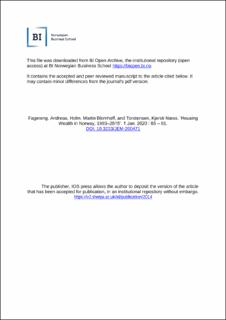| dc.contributor.author | Fagereng, Andreas | |
| dc.contributor.author | Holm, Martin Blomhoff | |
| dc.contributor.author | Torstensen, Kjersti Næss | |
| dc.date.accessioned | 2022-02-07T13:44:55Z | |
| dc.date.available | 2022-02-07T13:44:55Z | |
| dc.date.created | 2020-12-14T20:41:06Z | |
| dc.date.issued | 2020 | |
| dc.identifier.citation | Journal of Economic and Social Measurement, 2020, vol. 45, no. 1, pp. 65-81, | en_US |
| dc.identifier.issn | 0747-9662 | |
| dc.identifier.uri | https://hdl.handle.net/11250/2977541 | |
| dc.description | Note: [1] The article should not be reported as representing the views of Statistics Norway or Norges Bank. The views expressed are those of the authors and do not necessarily reflect those of Statistics Norway or Norges Bank. | en_US |
| dc.description.abstract | We provide a new estimate of household-level housing wealth in Norway between 1993 and 2015 using an ensemble machine learning method on housing transaction data. The new housing wealth measure is an improvement over existing data sources for two reasons. First, the model outperforms previously applied regression models in out-of-sample prediction precision. Second, we extend the sample of estimated housing wealth by including cooperative units, non-id apartments, and cabins. | en_US |
| dc.language.iso | eng | en_US |
| dc.publisher | IOS Press | en_US |
| dc.subject | Machine learning | en_US |
| dc.subject | Housing wealth | en_US |
| dc.subject | House prices | en_US |
| dc.title | Housing wealth in Norway, 1993–2015 | en_US |
| dc.type | Journal article | en_US |
| dc.type | Peer reviewed | en_US |
| dc.description.version | acceptedVersion | en_US |
| dc.source.pagenumber | 65-81 | en_US |
| dc.source.volume | 45 | en_US |
| dc.source.journal | Journal of Economic and Social Measurement | en_US |
| dc.source.issue | 1 | en_US |
| dc.identifier.doi | 10.3233/JEM-200471 | |
| dc.identifier.cristin | 1859741 | |
| cristin.ispublished | false | |
| cristin.fulltext | postprint | |
| cristin.qualitycode | 1 | |
